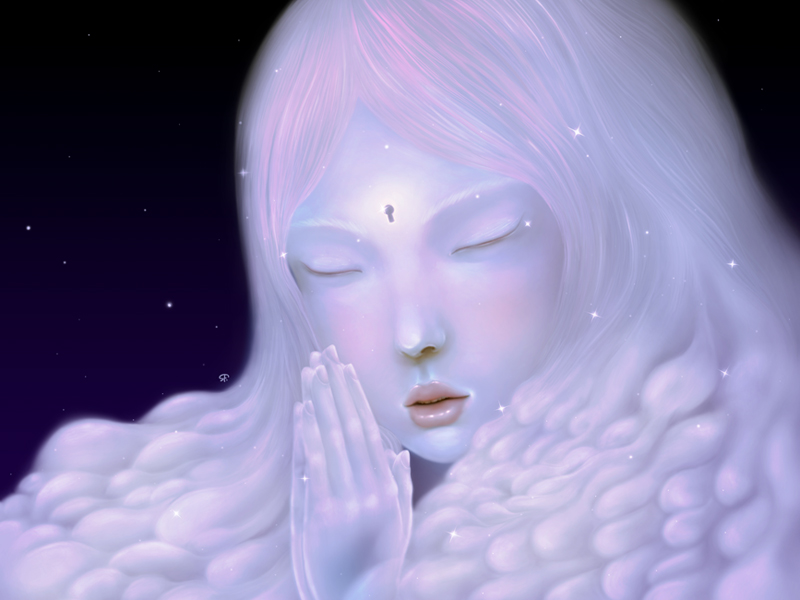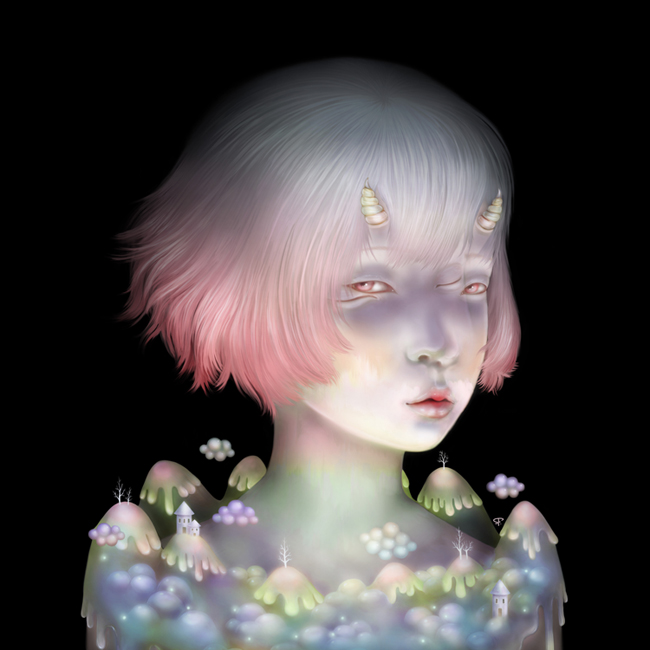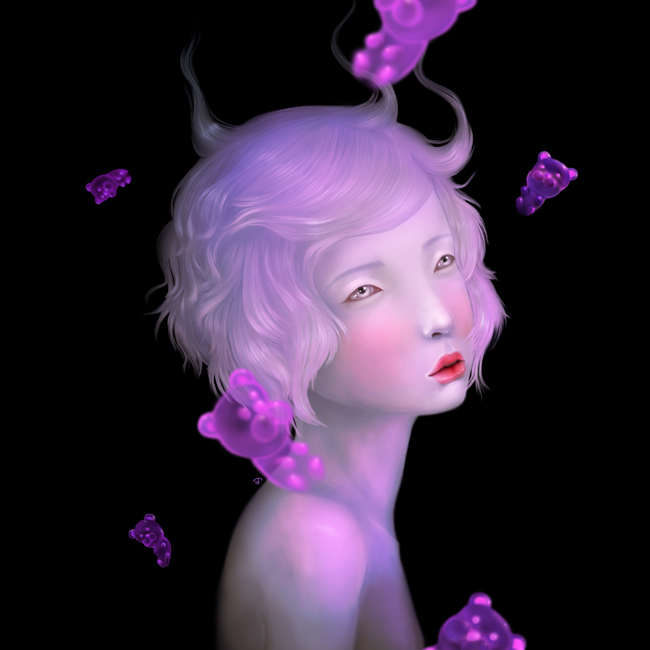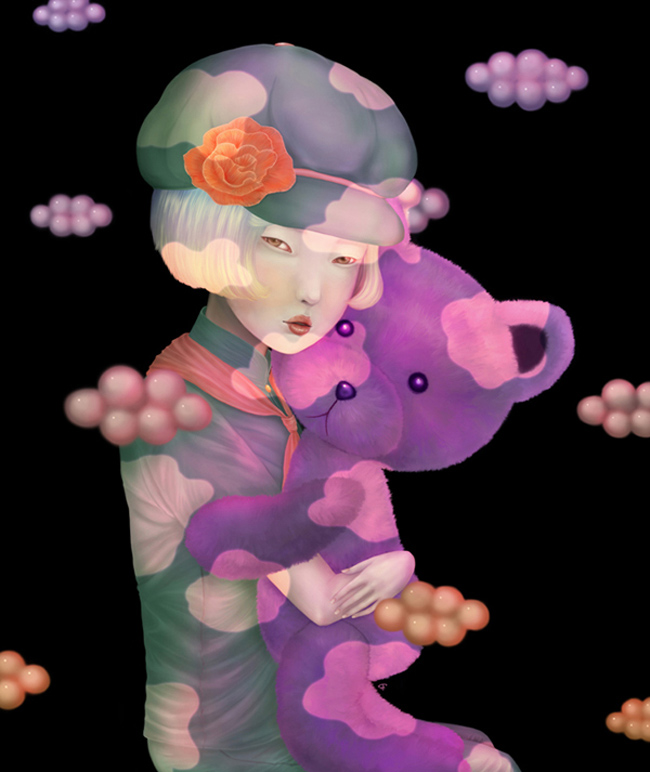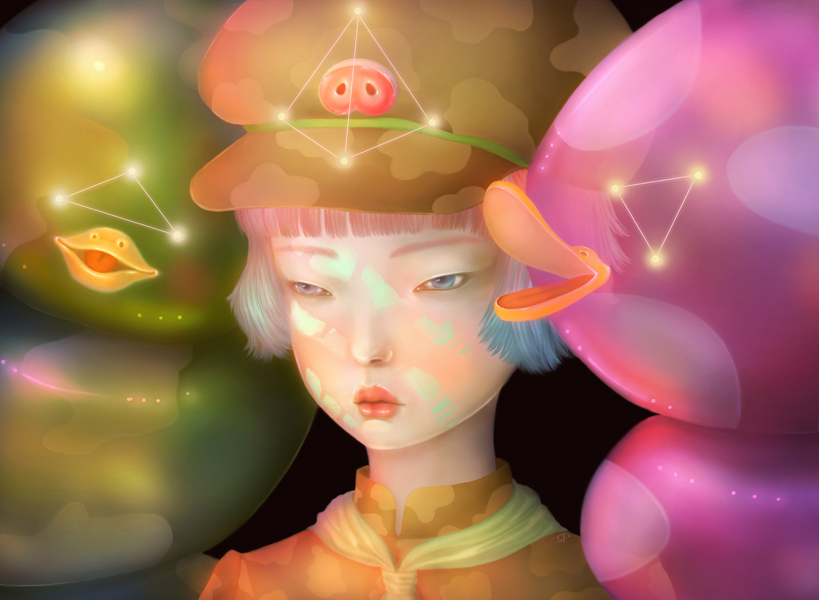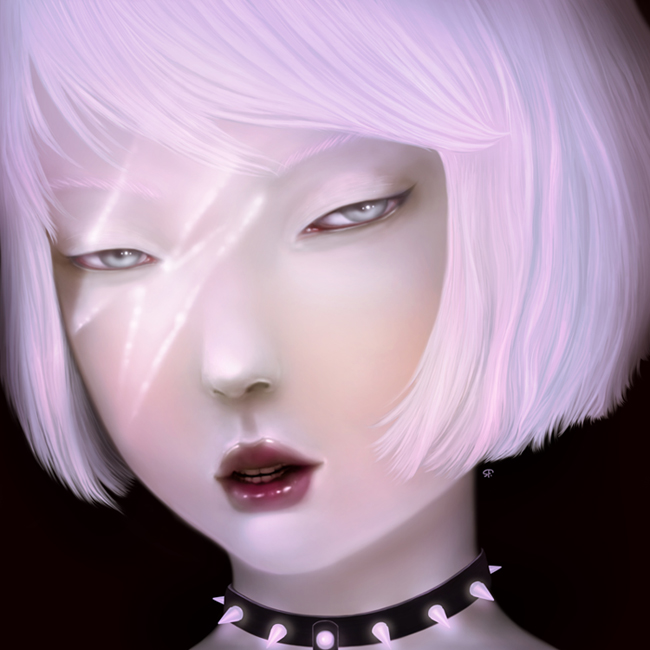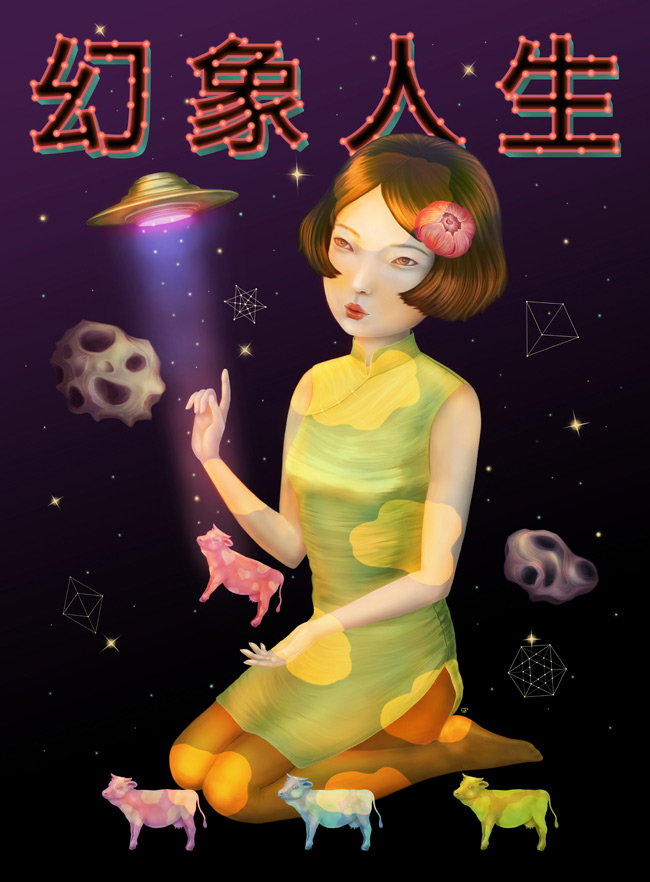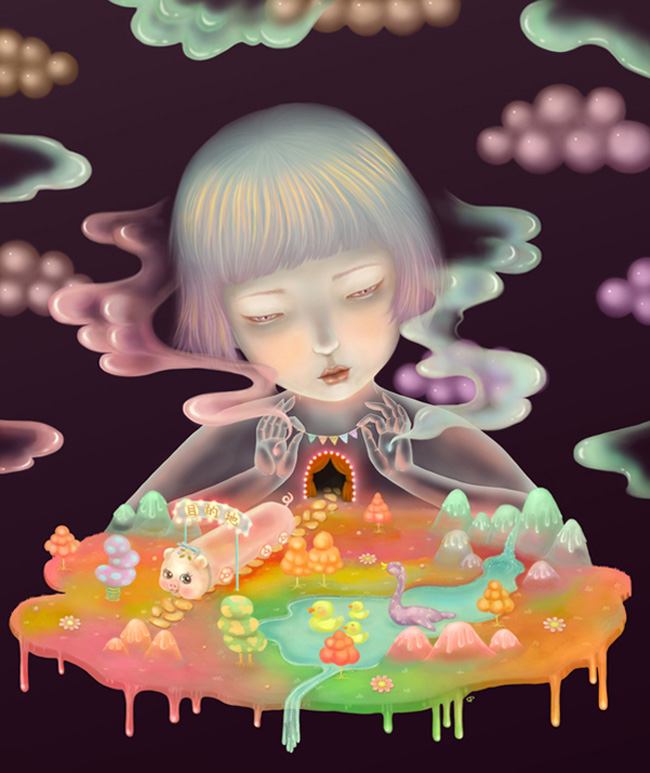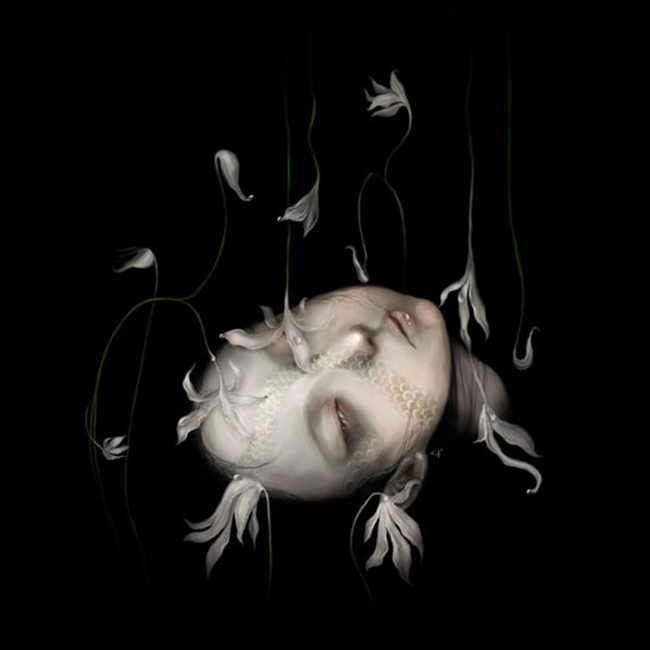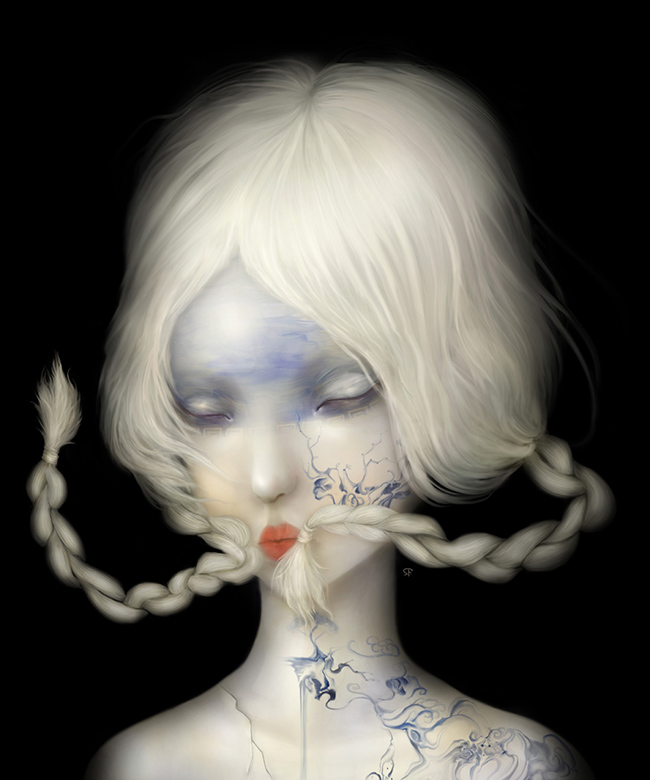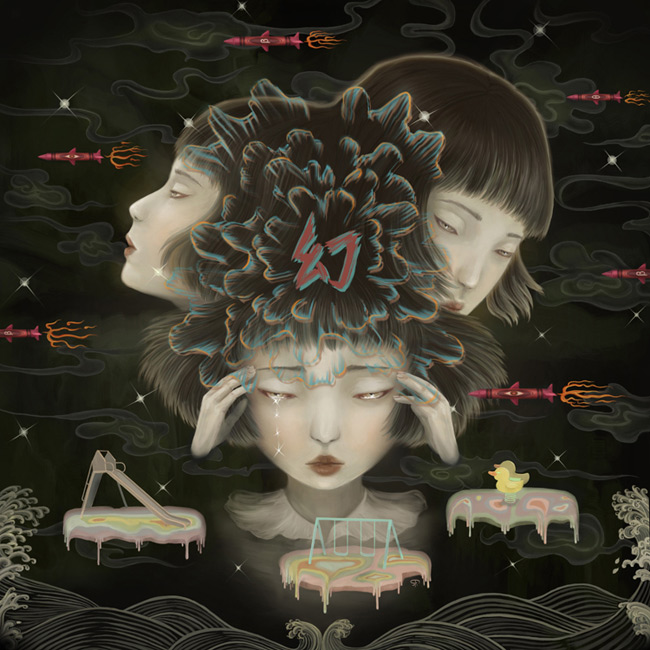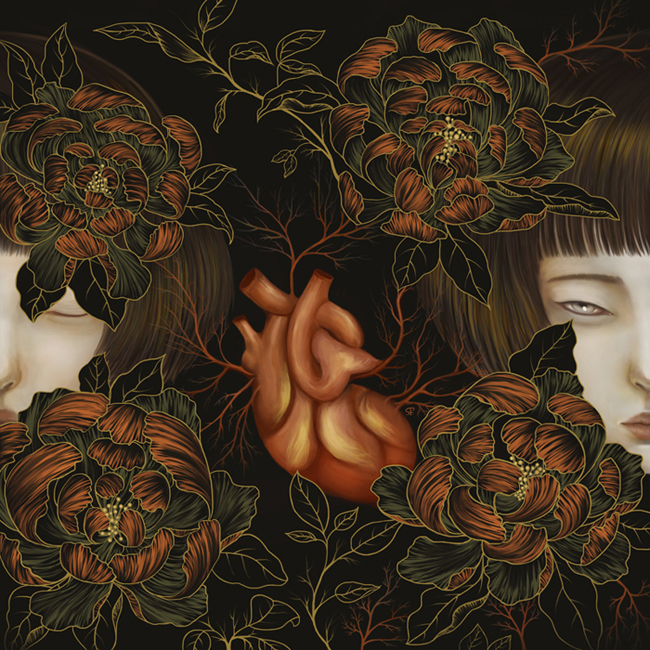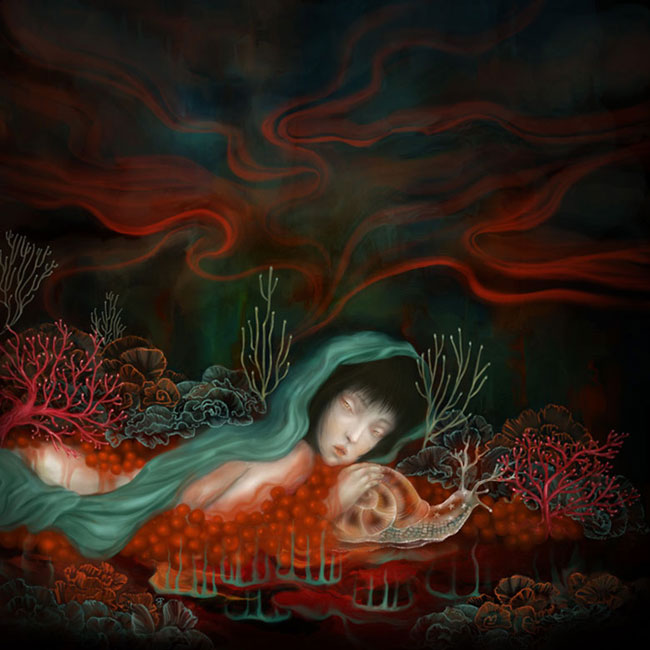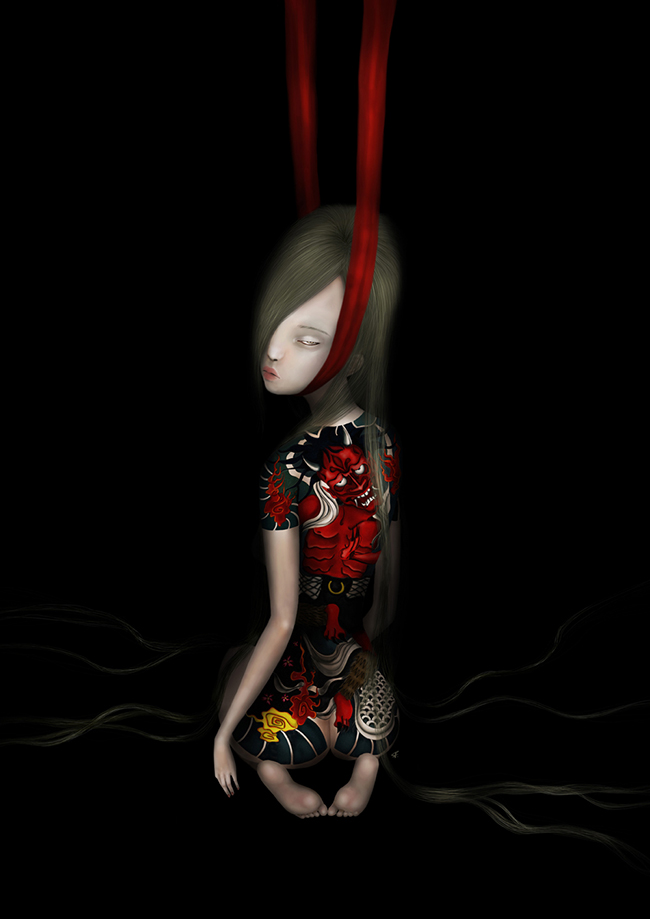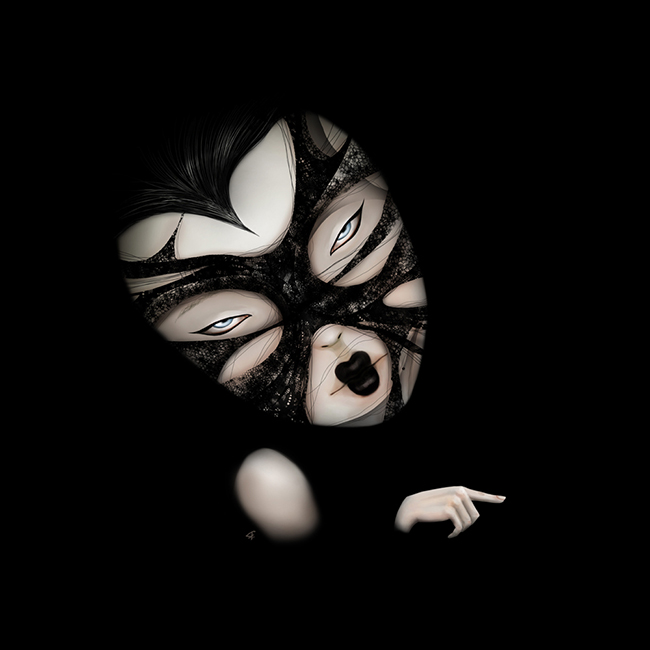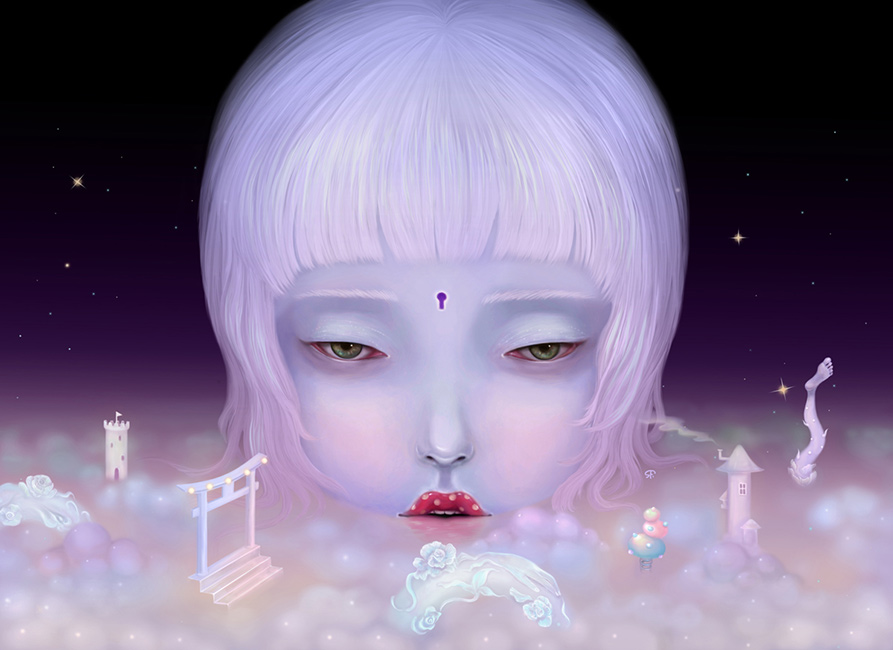Sonya Fu’s digital dreamscapes enchant with an ethereal symbolism and the glimpses they provide into the secret lives of her beautiful female protagonists. Largely inspired by Fu’s own hypnagogic experiences as she descends on the elevator from wakefulness to sleep, her narratives possess the familiar and yet ever so mysterious quality of being slowly enveloped by our dream worlds. These lucid thoughts and dreams which occur on the threshold of consciousness, carry with them their own unique language of metaphor and symbolism, which Fu listens to astutely and incorporates within her tales of wondrous surreality. Loaded with emotional charges tapped straight from their undiluted subconscious wellsprings, Fu’s imagery delivers an unadulterated wealth of raw power which is capable of communicating directly with our own innermost fears and fantasies.
Sonya Fu is a visual artist who was born in Hong Kong in 1982. Growing up in the former British Colony where East meets West, Fu has been influenced by both Oriental and Western culture. She worked a graphic designer for a number of years before turning her attentions towards her own fine art on a full-time basis, after her first gallery experience in 2010. Now focusing solely on what she loves, Sonya has shown her artwork internationally in cities such as, New York, Berlin, and Melbourne.
WOW x WOW is absolutely thrilled to have a brand-new piece by Sonya, entitled, ‘Night Poem III’ in ‘Lightning Bolts and Little Sparks’, our inaugural online exhibition. In honour of the occasion, we’re delighted to bring you the following exclusive interview with Sonya, in which you’ll learn more about her creative thoughts and practices. Enjoy!
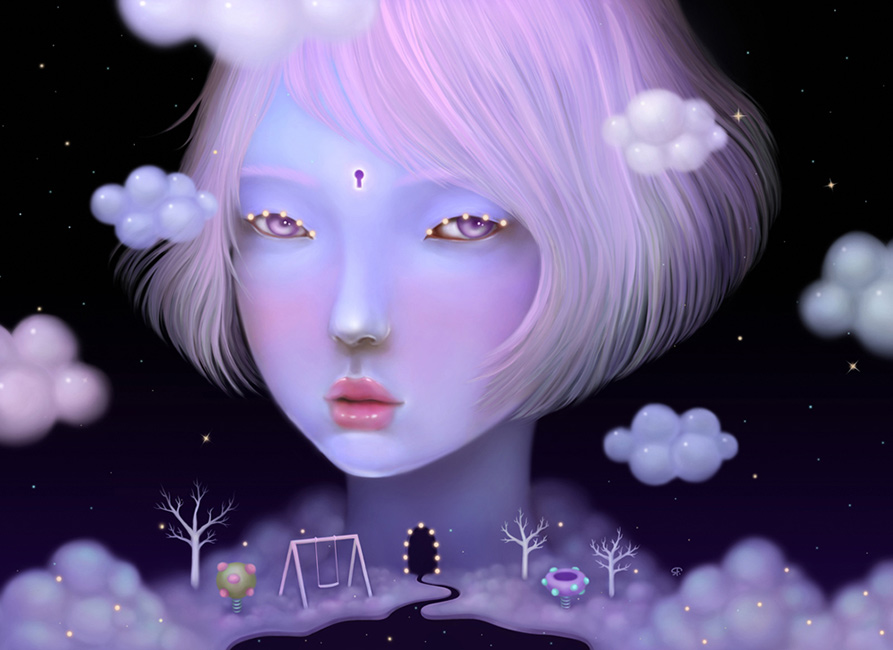
Hi Sonya, thanks very much for making the time to have a chat, we really appreciate it. To get us started, can you give us some background on what has led you to this point in your professional life, be it your formal training, serendipity, etc.?
I worked as a graphic designer before and art has always been a passion of mine. In 2010, I got my first group art exhibition, it went pretty well and that was when I decided to dedicate more time to my art and it has become my career.
We’re interested to hear about where you’re currently living and what you like about the area? What is the art scene like there and do you feel a part of that community? Are these aspects of your life that are important to your creativity?
I live in Hong Kong and I was born here. Hong Kong is a magical city, almost looks like somewhere out of the Blade Runner movie and it’s a melting pot of western and oriental cultures. Hong Kong is really small, you always run into familiar faces at art shows or events, so the art scene here is pretty cozy. Due to our east-meets-west culture, Hong Kong is a breeding ground for a diverse range of art from traditional Chinese ink and gongbi paintings to street art and multimedia art. I think yes, these aspects of my life are important to my creativity. My hometown is full of diversity and inspiration.
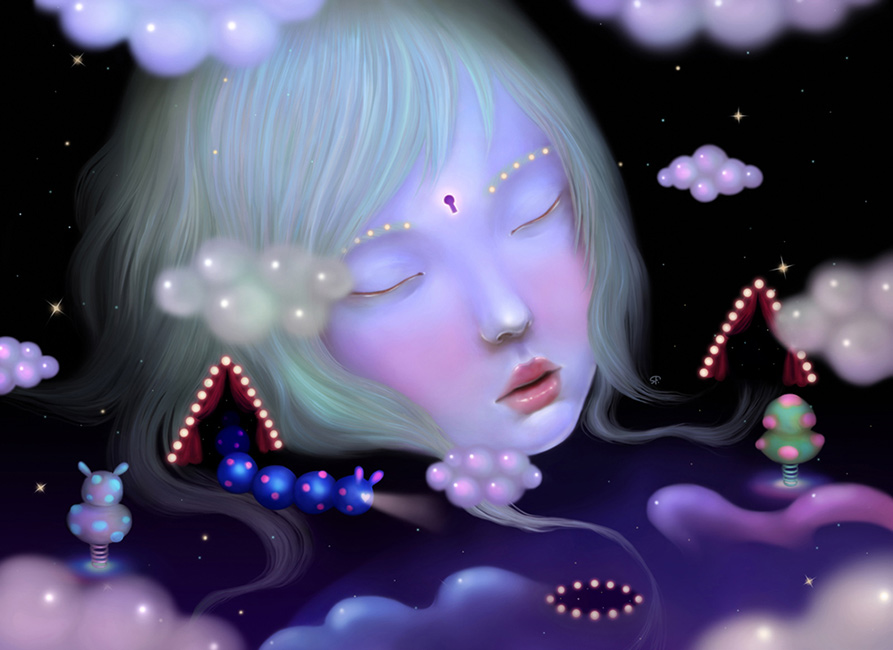
Talk to us about growing up. In what ways did your childhood and upbringing affect your relationship with the arts?
Back in the day, we didn’t have internet or cell phones, so making art is what I did for fun most of the time. When I was still in elementary school, I was an active participant in the coloring contests hosted by the local youth clubs and I have won a few first places in them. The secondary school I went to didn’t really care much about art, art class was cut on grade 9 and was replaced with other ‘more important subjects’ (Mathematics, Chinese, English, etc.). During that time, my notes and textbooks were constantly covered in doodles, well it somewhat helped me let out my creative energy. Tell you something funny, my marks got deducted several times because I doodled on my homework. Like there was this time I doodled cockroaches all over my geography assignment, the funny thing is my teacher was arsed enough to circle every one of them in red, haha, how I wish I had kept those! I guess I have always had a hankering to be an artist.
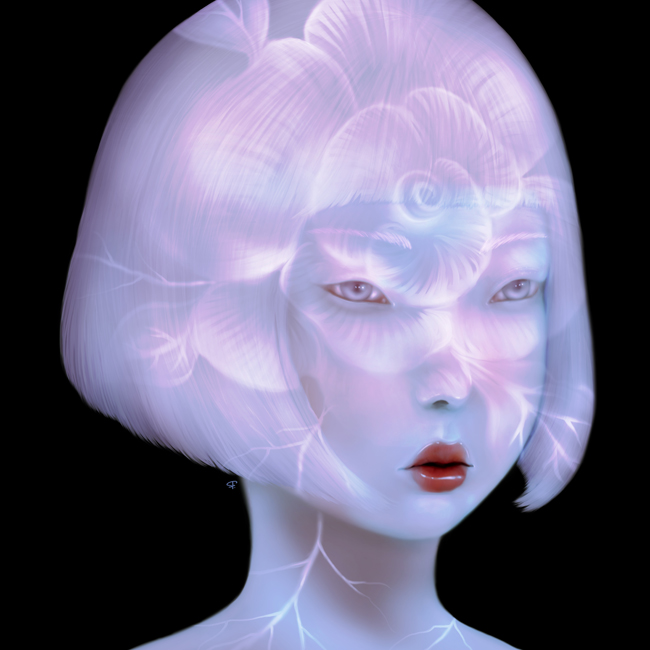
Given the surreal and dreamlike nature of the art you create, your unconscious mind is clearly something you nurture and look to during your creative process. Can you tell us about any techniques that you employ to tap into your subconscious or that help ideas rise to the surface?
I am mostly inspired by my dreams, beautiful ones or nightmares. I have very vivid dreams and I manage to recall a lot of them, it is natural for me! I meditate on a daily basis and I am greatly inspired by the flashes of images I see. As you can see, there are a lot of female characters in my work. An interesting technique I use is to see through their eyes, put myself in their places and start to visualize – How would they feel? What would they see? The scenery can be quite surprising sometimes; this is how some of the foregrounds of my paintings are created.
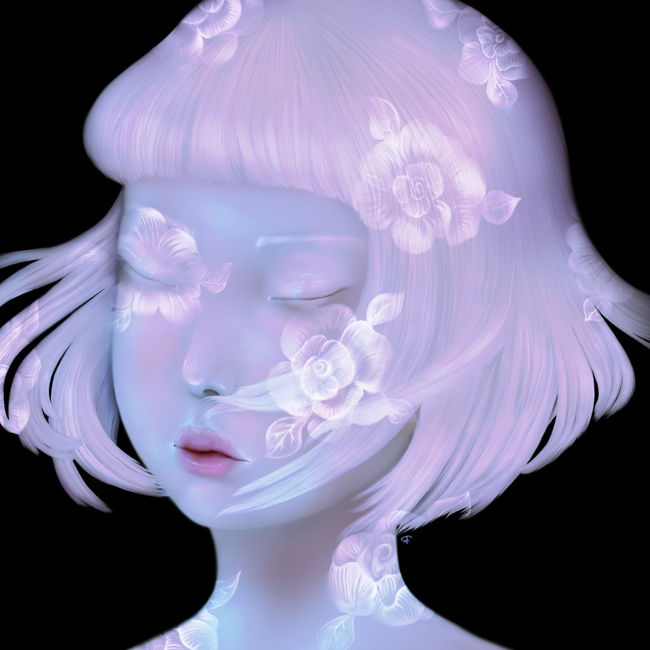
Do you always feel you have a clear understanding of meaning and intention behind the symbolism and narratives contained within your work, or have there been occasions when images you’ve created have revealed something to you after their completion; something that maybe you hadn’t been consciously thinking about while making them? If so, we’d love to hear about one such occasion.
It depends, sometimes I do and sometimes I don’t. For example my work ‘Tender Stillness’ from 2013 which I created for a themed group show about hybrid creatures, at time I was on a spiritual roller coaster, I wasn’t aware that I was projecting my feelings onto the painting. After I have finished the piece, the hybrid serpent girl I created haunted me several times in my dreams. She was way bigger than I imagined, I repeatedly dreamed about her hovering in the sky, destroying the surroundings of my apartment. The most unforgettable one was she finally caught me watching, she glared at me and was about to summon a tsunami. I screamed, “Help me!” and all of a sudden, something snatched her out of my sight. I ran towards the window trying to figure out what happened, and then a glowing huge white feathered wing blocked my window then swiftly disappeared. The dream went from brooding to pleasant and this was the last time I dreamed about the serpent girl. Now I think about it, she might be a manifestation of my unknown emotions during that time. On a side note, I am currently working on a piece which the serpent girl is also in it. It sounds silly but it’s like a ritual, I feel like I have delivered her to a better plane of existence where she is able to dive in tranquillity now.
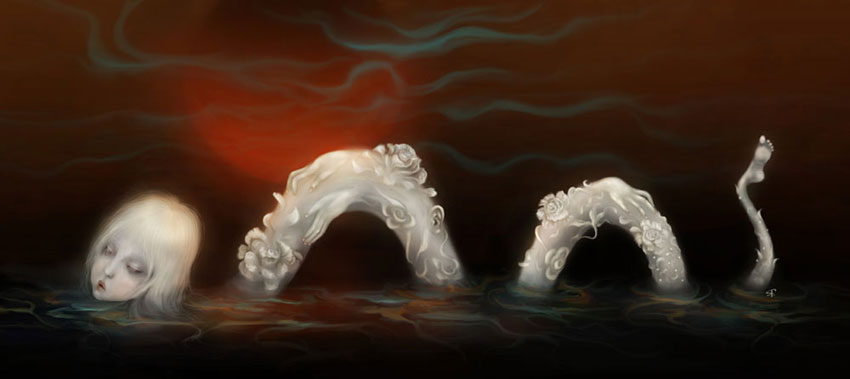
As we move through life we continue to grow and change. In what ways have you seen the themes you’ve been exploring with your work evolve since you started down the path of being a professional artist?
I have been jumping back and forth between themes and palettes, from ‘Dark’ to ‘Sweet’, ‘Pale’ to ‘Vibrant’ and ‘Somewhere in Between’. After many experiments, I’ve managed to find a balance and learn to work in a coherent fashion, thus I mostly work in series now.
Having spoken to a good number of digital artists, many of them have commented on the misconceptions that people often have about digital artwork. What have been your experiences in this regard and are there any common misconceptions that you would like to address or set straight?
There is no magic button; every piece takes time and effort. Though digitally, I prefer to paint brush stroke after brush stroke with my Wacom tablet. Like many other things, there are pros and cons to digital media. There are quite a few conveniences that digital media offers: not having to wait for the paint to dry, having an easier time to fix mistakes in a less messy manner, etc. However, there is no easy way when it comes to practicing and understanding color, light, anatomy, composition, sense of aesthetics and the like. I hope people understand that traditional and digital media involve different techniques, yet they demand the same amount of dedication. It would be unfair to say one media is superior to the other. As much as I enjoy my chosen media, I have my full respect and appreciation for artists who work in all forms of media, digital or traditional.
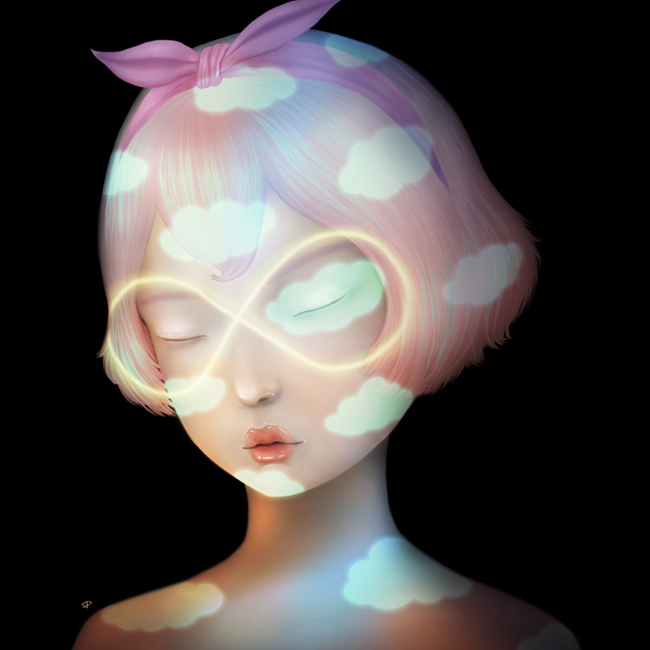
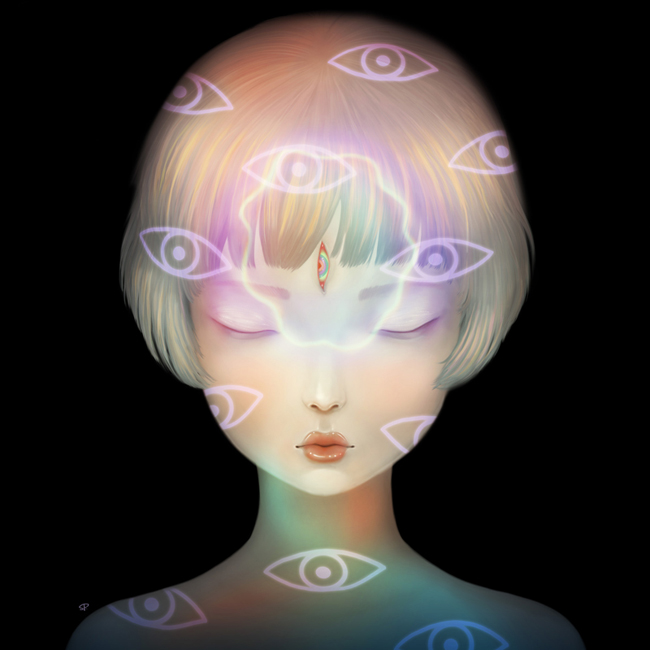
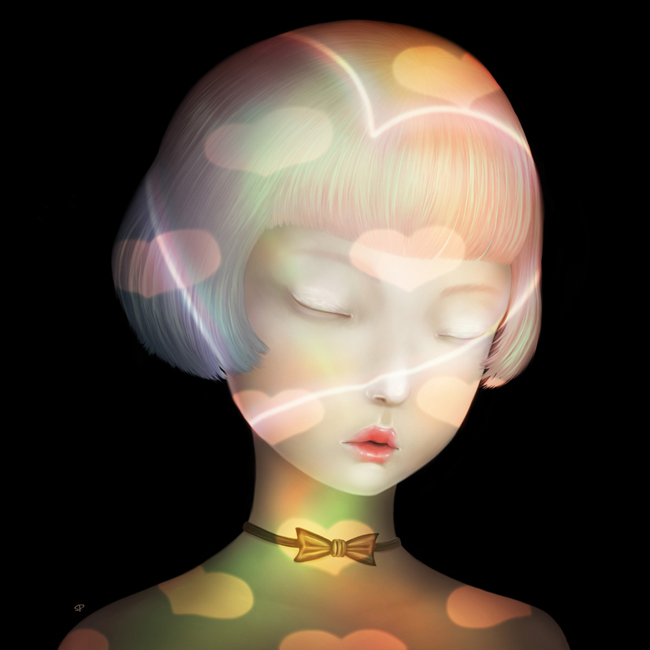
What do you believe your role is as a contemporary artist?
To spice up people’s moods and bring delightful surreal experiences through my visual narrative!
What do you know now that you wish you had known when you were first starting down the path of becoming an artist?
The balance between compromising and standing my ground.
If you could own one piece of art from any of the world’s collections what would it be and why?
‘The Garden of Earthly Delights’ by the old master Hieronymus Bosch! It’s full of excellence and sense of humor, one simply doesn’t get bored looking at this triptych!
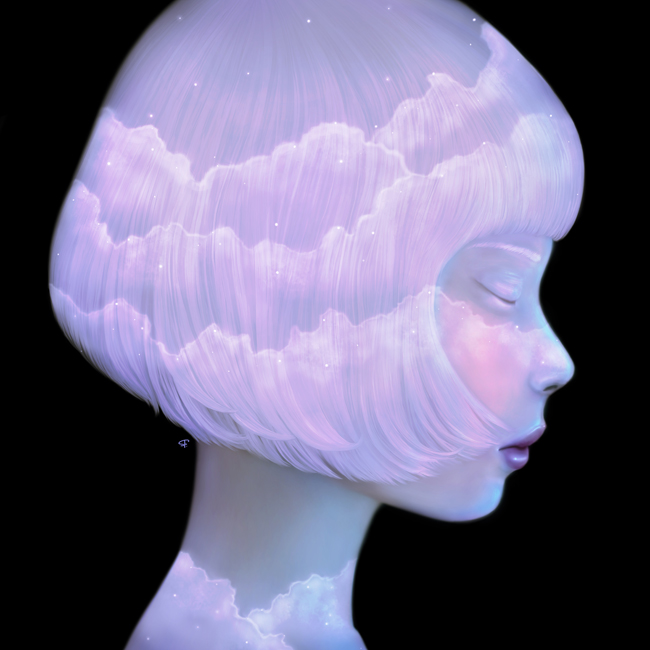
In order to get a better understanding of the personality of an artist, it can help to get a peek behind the curtain. Would you be willing to share a story from your own life, possibly one whose memory you find yourself returning to for inspiration, or maybe just a tale about a hardship you’ve overcome which has helped define the person and therefore artist that you are now?
I find myself always go back to my childhood memory of a playground that I used to visit often. Alas, the playground had a makeover many years ago, my favorite swings, spring riders and spinner have been removed. I miss this place a lot I even dream about it often, though it looks different and more whimsical in my dreams; particularly the spring riders, they move around the playground and talk in delicate voices as if they have lives of their own. I am totally fascinated by these eerie creatures, thus they have become a recurring element in my paintings. I feel really nostalgic about my childhood playground just talking about it now! It looks completely different after the makeover, but the old playground will forever be living in my memory.
What’s next for Sonya Fu?
I would like to work on a side project.
